Peptidases Are Potential Targets of Copper(II)-1,10-Phenanthroline-5,6-dione Complex, a Promising and Potent New Drug against Trichomonas vaginalis
Abstract
1. Introduction
2. Materials and Methods
2.1. Parasites
2.2. Treatment
2.3. Computational Analysis of TvMP50, TvGP63, and TvCP2
2.4. Proteolytic Activity Assay
2.5. Sodium Dodecyl Sulfate–Polyacrylamide Gel Electrophoresis (SDS-PAGE) Assay
2.6. Mass Spectrometry Analysis
2.7. Expression of mRNA through qRT-PCR
2.8. Mammalian Cell LDH Release Assay
2.9. Statistical Analysis
3. Results and Discussion
3.1. Docking Analysis Reveals That Cu-Phendione Interacts with the Active Site of TvMP50, TvGP63, and TvCP2
3.2. Cu-Phendione Inhibits the Peptidase Activities of T. vaginalis
3.3. Cu-Phendione Negatively Modulates Peptidase Production in T. vaginalis Cells
3.4. Cu-Phendione Modulates the Expression of Peptidase Genes in T. vaginalis
3.5. Cu-Phendione Reduces the Cytolysis Induced by T. vaginalis in Mammalian Cells
4. Conclusions
Supplementary Materials
Author Contributions
Funding
Institutional Review Board Statement
Informed Consent Statement
Data Availability Statement
Conflicts of Interest
References
- Rowley, J.; Vander Hoorn, S.; Korenromp, E.; Low, N.; Unemo, M.; Abu-Raddad, L.J.; Chico, R.M.; Smolak, A.; Newman, L.; Gottlieb, S.; et al. Chlamydia, gonorrhoea, trichomoniasis and syphilis: Global prevalence and incidence estimates, 2016. Bull. World Health Organ. 2019, 97, 548–562. [Google Scholar] [CrossRef] [PubMed]
- Menezes, C.B.; Frasson, A.P.; Tasca, T. Trichomoniasis—Are we giving the deserved attention to the most common non-viral sexually transmitted disease worldwide? Microb. Cell. 2016, 3, 404–419. [Google Scholar] [CrossRef]
- Rawlings, N.D.; Barrett, A.J.; Thomas, P.D.; Huang, X.; Bateman, A.; Finn, R.D. The MEROPS database of proteolytic enzymes, their substrates and inhibitors in 2017 and a comparison with peptidases in the PANTHER database. Nucleic Acids Res. 2018, 46, D624–D632. [Google Scholar] [CrossRef] [PubMed]
- Carlton, J.M.; Hirt, R.P.; Silva, J.C.; Delcher, A.L.; Schatz, M.; Zhao, Q.; Wortman, J.R.; Bidwell, S.L.; Alsmark, U.C.; Besteiro, S.; et al. Draft genome sequence of the sexually transmitted pathogen Trichomonas vaginalis. Science 2007, 315, 207–212. [Google Scholar] [CrossRef]
- Draper, D.; Donohoe, W.; Mortimer, L.; Heine, R.P. Cysteine proteases of Trichomonas vaginalis degrade secretory leukocyte protease inhibitor. J. Infect. Dis. 1998, 178, 815–819. [Google Scholar] [CrossRef] [PubMed]
- Santos, A.L.S. Protease expression by microorganisms and its relevance to crucial physiological/pathological events. World J. Biol. Chem. 2011, 2, 48–58. [Google Scholar] [CrossRef]
- Nguyen, T.T.H.; Myrold, D.D.; Mueller, R.S. Distributions of Extracellular Peptidases Across Prokaryotic Genomes Reflect Phylogeny and Habitat. Front. Microbiol. 2019, 10, 413. [Google Scholar] [CrossRef]
- Štáfková, J.; Rada, P.; Meloni, D.; Žárský, V.; Smutná, T.; Zimmann, N.; Harant, K.; Pompach, P.; Hrdý, I.; Tachezy, J. Dynamic secretome of Trichomonas vaginalis: Case study of β-amylases. Mol. Cell Proteom. 2018, 17, 304–320. [Google Scholar] [CrossRef]
- Arroyo, R.; Cárdenas-Guerra, R.E.; Figueroa-Angulo, E.E.; Puente-Rivera, J.; Zamudio-Prieto, O.; Ortega-López, J. Trichomonas vaginalis Cysteine Proteinases: Iron Response in Gene Expression and Proteolytic Activity. Biomed. Res. Int. 2015, 2015, 946787. [Google Scholar] [CrossRef]
- Puente-Rivera, J.; Villalpando, J.L.; Villalobos-Osnaya, A.; Vázquez-Carrillo, L.I.; León-Ávila, G.; Ponce-Regalado, M.D.; López-Camarillo, C.; Elizalde-Contreras, J.M.; Ruiz-May, E.; Arroyo, R.; et al. The 50kDa metalloproteinase TvMP50 is a zinc-mediated Trichomonas vaginalis virulence factor. Mol. Biochem. Parasitol. 2017, 217, 32–41. [Google Scholar] [CrossRef]
- Arreola, R.; Villalpando, J.L.; Puente-Rivera, J.; Morales-Montor, J.; Rudiño-Piñera, E.; Alvarez-Sánchez, M.E. Trichomonas vaginalis metalloproteinase TvMP50 is a monomeric Aminopeptidase P-like enzyme. Mol. Biotechnol. 2018, 60, 563–575. [Google Scholar] [CrossRef] [PubMed]
- Ma, L.; Meng, Q.; Cheng, W.; Sung, Y.; Tang, P.; Hu, S.; Yu, J. Involvement of the GP63 protease in infection of Trichomonas vaginalis. Parasitol. Res. 2011, 109, 71–79. [Google Scholar] [CrossRef] [PubMed]
- Quan, J.H.; Kang, B.H.; Cha, G.H.; Zhou, W.; Koh, Y.B.; Yang, J.B.; Yoo, H.J.; Lee, M.A.; Ryu, J.S.; Noh, H.T.; et al. Trichonomas vaginalis metalloproteinase induces apoptosis of SiHa cells through disrupting the Mcl-1/Bim and Bcl-xL/Bim complexes. PLoS ONE 2014, 9, e110659. [Google Scholar] [CrossRef]
- Viganor, L.; Galdino, A.C.; Nunes, A.P.; Santos, K.R.; Branquinha, M.H.; Devereux, M.; Kellett, A.; McCann, M.; dos Santos, A.L. Anti-Pseudomonas aeruginosa activity of 1,10-phenanthroline-based drugs against both planktonic- and biofilm-growing cells. J. Antimicrob. Chemother. 2016, 71, 128–134. [Google Scholar] [CrossRef] [PubMed]
- Granato, M.Q.; Gonçalves, D.S.; Seabra, S.H.; McCann, M.; Devereux, M.; dos Santos, A.L.; Kneipp, L.F. 1,10-Phenanthroline-5,6-Dione-Based Compounds Are Effective in Disturbing Crucial Physiological Events of Phialophora verrucosa. Front. Microbiol. 2017, 8, 76. [Google Scholar] [CrossRef]
- Lima, A.K.C.; Elias, C.G.R.; Oliveira, S.S.C.; Santos-Mallet, J.R.; McCann, M.; Devereux, M.; Branquinha, M.H.; Dutra, P.M.L.; dos Santos, A.L.S. Anti-Leishmania braziliensis activity of 1,10-phenanthroline-5,6-dione and its Cu(II) and Ag(I) complexes. Parasitol. Res. 2021, 120, 3273–3285. [Google Scholar] [CrossRef]
- Galdino, A.C.M.; Viganor, L.; Castro, A.A.; Cunha, E.F.F.; Mello, T.P.; Mattos, L.M.; Pereira, M.D.; Hunt, M.C.; O’Shaughnessy, M.; Howe, O.; et al. Disarming Pseudomonas aeruginosa Virulence by the Inhibitory Action of 1,10-Phenanthroline-5,6-Dione-Based Compounds: Elastase B (LasB) as a Chemotherapeutic Target. Front. Microbiol. 2019, 10, 1701. [Google Scholar] [CrossRef]
- Rigo, G.V.; Petro-Silveira, B.; Devereux, M.; McCann, M.; dos Santos, A.L.S.; Tasca, T. Anti-Trichomonas vaginalis activity of 1,10-phenanthroline-5,6-dione-based metallodrugs and synergistic effect with metronidazole. Parasitology 2018, 146, 1179–1183. [Google Scholar] [CrossRef]
- Oliveira, S.S.C.; Santos, V.S.; Devereux, M.; Mccann, M.; Santos, A.L.S.; Branquinha, M.H. The anti-Leishmania amazonensis and anti-Leishmania chagasi action of copper(II) and silver(I) 1,10-phenanthroline-5,6-dione coordination compounds. Pathogens 2023, 12, 70. [Google Scholar] [CrossRef]
- Rigo, G.V.; Willig, J.B.; Devereux, M.; McCann, M.; Santos, A.L.S.; Tasca, T. Oxidative damage by 1,10-phenanthroline-5,6-dione and its silver and copper complexes lead to apoptotic-like death in Trichomonas vaginalis. Res. Microbiol. 2022, 4, 104015. [Google Scholar]
- Diamond, L.S. The establishment of various trichomonads of animals and man in axenic cultures. J. Parasitol. 1957, 43, 488–490. [Google Scholar] [CrossRef] [PubMed]
- McCann, M.; Coyle, B.; McKay, S.; McCormack, P.; Kavanagh, K.; Devereux, M.; McKee, V.; Kinsella, P.; O’Connor, R.; Clynes, M. Synthesis and X-ray crystal structure of [Ag(phendio)2]ClO4 (phendio = 1,10-phenanthroline- 5,6-dione) and its effects on fungal and mammalian cells. Biometals 2004, 17, 635–645. [Google Scholar] [CrossRef] [PubMed]
- Jumper, J.; Evans, R.; Pritzel, A.; Green, T.; Figurnov, M.; Ronneberger, O.; Tunyasuvunakool, K.; Bates, R.; Žídek, A.; Potapenko, A.; et al. Highly accurate protein structure prediction with AlphaFold. Nature 2021, 596, 583–589. [Google Scholar] [CrossRef] [PubMed]
- Martínez-Rosell, G.; Giorgino, T.; de Fabritiis, G. PlayMolecule ProteinPrepare: A Web Application for Protein Preparation for Molecular Dynamics Simulations. J. Chem. Inf. Model. 2017, 57, 1511–1516. [Google Scholar] [CrossRef]
- Trott, O.; Olson, A.J. AutoDock Vina: Improving the speed and accuracy of docking with a new scoring function, efficient optimization, and multithreading. J. Comput. Chem. 2010, 31, 455–461. [Google Scholar] [CrossRef]
- Morris, G.M.; Huey, R.; Lindstrom, W.; Sanner, M.F.; Belew, R.K.; Goodsell, D.S.; Olson, A.J. AutoDock4 and AutoDockTools4: Automated docking with selective receptor flexibility. J. Comput. Chem. 2009, 30, 2785–2791. [Google Scholar] [CrossRef]
- Weber, J.I.; Rigo, G.V.; Rocha, D.A.; Fortes, I.S.; Seixas, A.; de Andrade, S.F.; Tasca, T. Modulation of peptidases by 2,4-diamine-quinazoline derivative induces cell death in the amitochondriate parasite Trichomonas vaginalis. Biomed. Pharmacother. 2021, 139, 111611. [Google Scholar] [CrossRef]
- Bradford, M.M. A rapid and sensitive method for the quantitation of microgram quantities of protein utilizing the principle of protein-dye binding. Anal. Biochem. 1976, 72, 248–254. [Google Scholar] [CrossRef]
- Martinelli, A.H.; Kappaun, K.; Ligabue-Braun, R.; Defferrari, M.S.; Piovesan, A.R.; Stanisçuaski, F.; Demartini, D.R.; Dal Belo, C.A.; Almeida, C.G.; Follmer, C.; et al. Structure-function studies on jaburetox, a recombinant insecticidal peptide derived from jack bean (Canavalia ensiformis) urease. Biochim. Biophys. Acta 2014, 1840, 935–944. [Google Scholar] [CrossRef]
- Rio, D.C.; Ares, M.J.R.; Hannon, G.J.; Nilsen, T.W. Purification of RNA using TRIzol (TRI reagent). Cold. Spring. Harb. Protoc. 2010, 6, 5439. [Google Scholar] [CrossRef]
- Santos, O.; Rigo, G.V.; Frasson, A.P.; Macedo, A.J.; Tasca, T. Optimal Reference Genes for Gene Expression Normalization in Trichomonas vaginalis. PLoS ONE 2015, 10, e0138331. [Google Scholar] [CrossRef]
- Mariani, V.; Biasini, M.; Barbato, A.; Schwede, T. lDDT: A local superposition-free score for comparing protein structures and models using distance difference tests. Bioinformatics 2013, 29, 2722–2728. [Google Scholar] [CrossRef]
- Gomis-Rüth, F. Structure and Mechanism of Metallocarboxypeptidases. Crit. Rev. Biochem. Mol. Biol. 2008, 43, 319–345. [Google Scholar] [CrossRef]
- Coêlho, D.F.; Saturnino, T.P.; Fernandes, F.F.; Mazzola, P.G.; Silveira, E.; Tambourgi, E.B. Azocasein Substrate for Determination of Proteolytic Activity: Reexamining a Traditional Method Using Bromelain Samples. Biomed. Res. Int. 2016, 2016, 8409183. [Google Scholar] [CrossRef]
- Hernández, H.; Sariego, I.; Garber, G.; Delgado, R.; López, O.; Sarracent, J. Monoclonal antibodies against a 62 kDa proteinase of Trichomonas vaginalis decrease parasite cytoadherence to epithelial cells and confer protection in mice. Parasite Immunol. 2004, 26, 119–125. [Google Scholar] [CrossRef] [PubMed]
- Quintas-Granados, L.I.; Villalpando, J.L.; Vázquez-Carrillo, L.I.; Arroyo, R.; Mendoza-Hernández, G.; Alvarez-Sánchez, M.E. TvMP50 is an immunogenic metalloproteinase during male trichomoniasis. Mol. Cell Proteomics 2013, 12, 1953–1964. [Google Scholar] [CrossRef] [PubMed]
- Cárdenas-Guerra, R.E.; Arroyo, R.; Rosa de Andrade, I.; Benchimol, M.; Ortega-López, J. The iron-induced cysteine proteinase TvCP4 plays a key role in Trichomonas vaginalis haemolysis. Microbes Infect. 2013, 15, 958–968. [Google Scholar] [CrossRef]
- Carvajal-Gamez, B.I.; Quintas-Granados, L.I.; Arroyo, R.; Vázquez-Carrillo, L.I.; Ramón-Luing, L.L.; Carrillo-Tapia, E.; Alvarez-Sánchez, M.E. Putrescine-dependent re-localization of TvCP39, a cysteine proteinase involved in Trichomonas vaginalis cytotoxicity. PLoS ONE 2014, 9, e107293. [Google Scholar] [CrossRef] [PubMed]
- Mancilla-Olea, M.I.; Ortega-López, J.; Figueroa-Angulo, E.E.; Avila-González, L.; Cárdenas-Guerra, R.E.; Miranda-Ozuna, J.F.T.; González-Robles, A.; Hernández-García, M.S.; Sánchez-Ayala, L.; Arroyo, R. Trichomonas vaginalis cathepsin D-like aspartic proteinase (Tv-CatD) is positively regulated by glucose and degrades human hemoglobin. Int. J. Biochem. Cell Biol. 2018, 97, 1–15. [Google Scholar] [CrossRef] [PubMed]
- Atkinson, H.J.; Babbitt, P.C.; Sajid, M. The global cysteine peptidase landscape in parasites. Trends Parasitol. 2009, 25, 573–581. [Google Scholar] [CrossRef] [PubMed]
- Jacob, F.; Monod, J. Genetic regulatory mechanisms in the synthesis of proteins. J. Mol. Biol. 1961, 3, 318–356. [Google Scholar] [CrossRef]
- Bastida-Corcuera, F.D.; Okumura, C.Y.; Colocoussi, A.; Johnson, P.J. Trichomonas vaginalis lipophosphoglycan mutants have reduced adherence and cytotoxicity to human ectocervical cells. Eucaryot. Cell. 2005, 4, 1951–1958. [Google Scholar] [CrossRef]
- Alvarez-Sánchez, M.E.; Carvajal-Gamez, B.I.; Solano-González, E.; Martínez-Benitez, M.; Garcia, A.F.; Alderete, J.F.; Arroyo, R. Polyamine depletion down-regulates expression of the Trichomonas vaginalis cytotoxic CP65, a 65-kDa cysteine proteinase involved in cellular damage. Int. J. Biochem. Cell Biol. 2008, 40, 2442–2451. [Google Scholar] [CrossRef] [PubMed]
- Ramón-Luing, L.L.; Rendón-Gandarilla, F.J.; Puente-Rivera, J.; Ávila-González, L.; Arroyo, R. Identification and characterization of the immunogenic cytotoxic TvCP39 proteinase gene of Trichomonas vaginalis. Int. J. Biochem. Cell Biol. 2011, 43, 1500–1511. [Google Scholar] [CrossRef] [PubMed]
- Cáceres-Castillo, D.; Pérez-Navarro, Y.; Torres-Romero, J.C.; Mirón-López, G.; Ceballos-Cruz, J.; Arana-Argáez, V.; Vázquez-Carrillo, L.; Fernández-Sánchez, J.M.; Alvarez-Sánchez, M.E. Trichomonicidal activity of a new anthraquinone isolated from the roots of Morinda panamensis Seem. Drug Dev Res. 2019, 80, 155–161. [Google Scholar] [CrossRef] [PubMed]

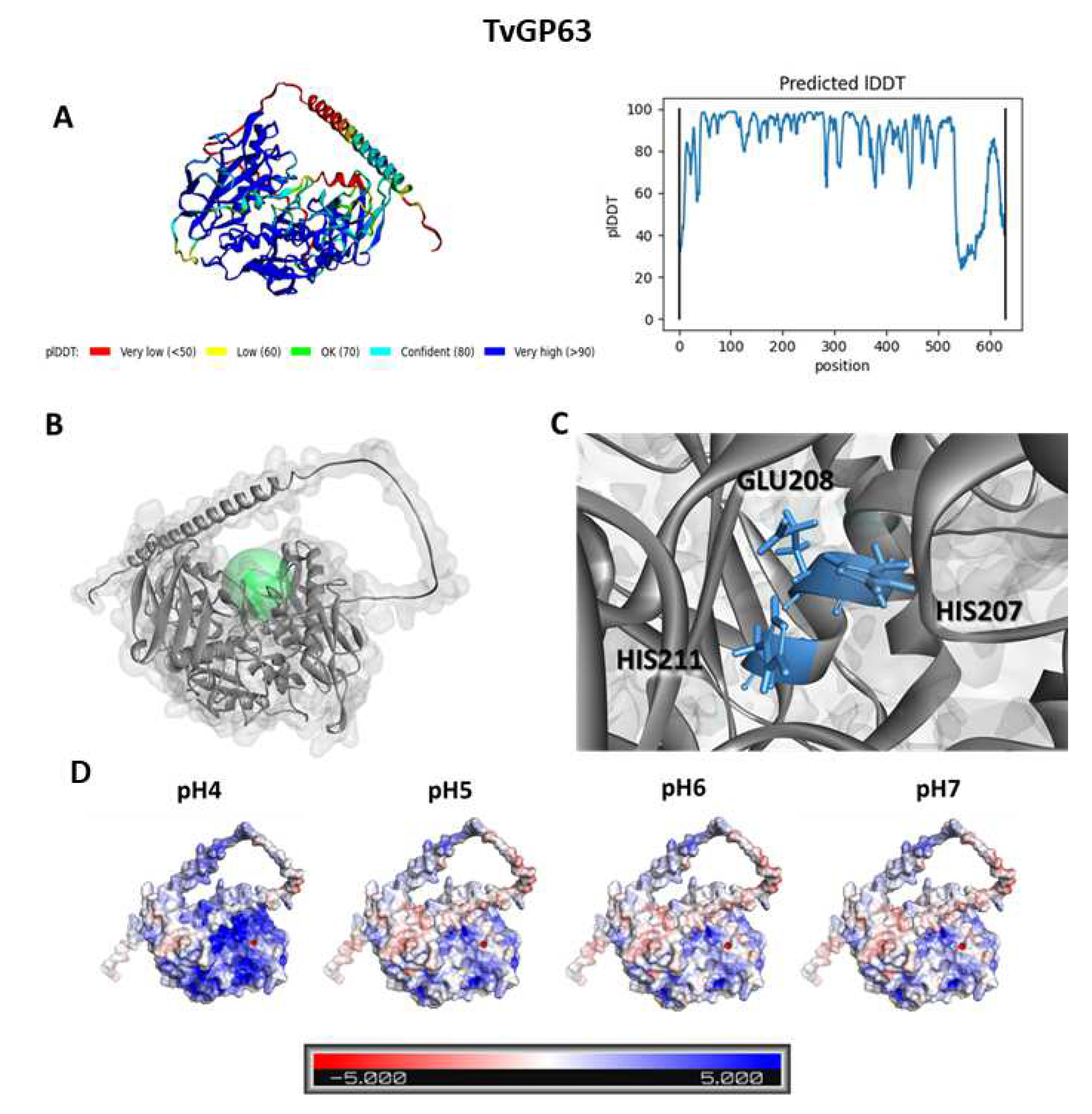
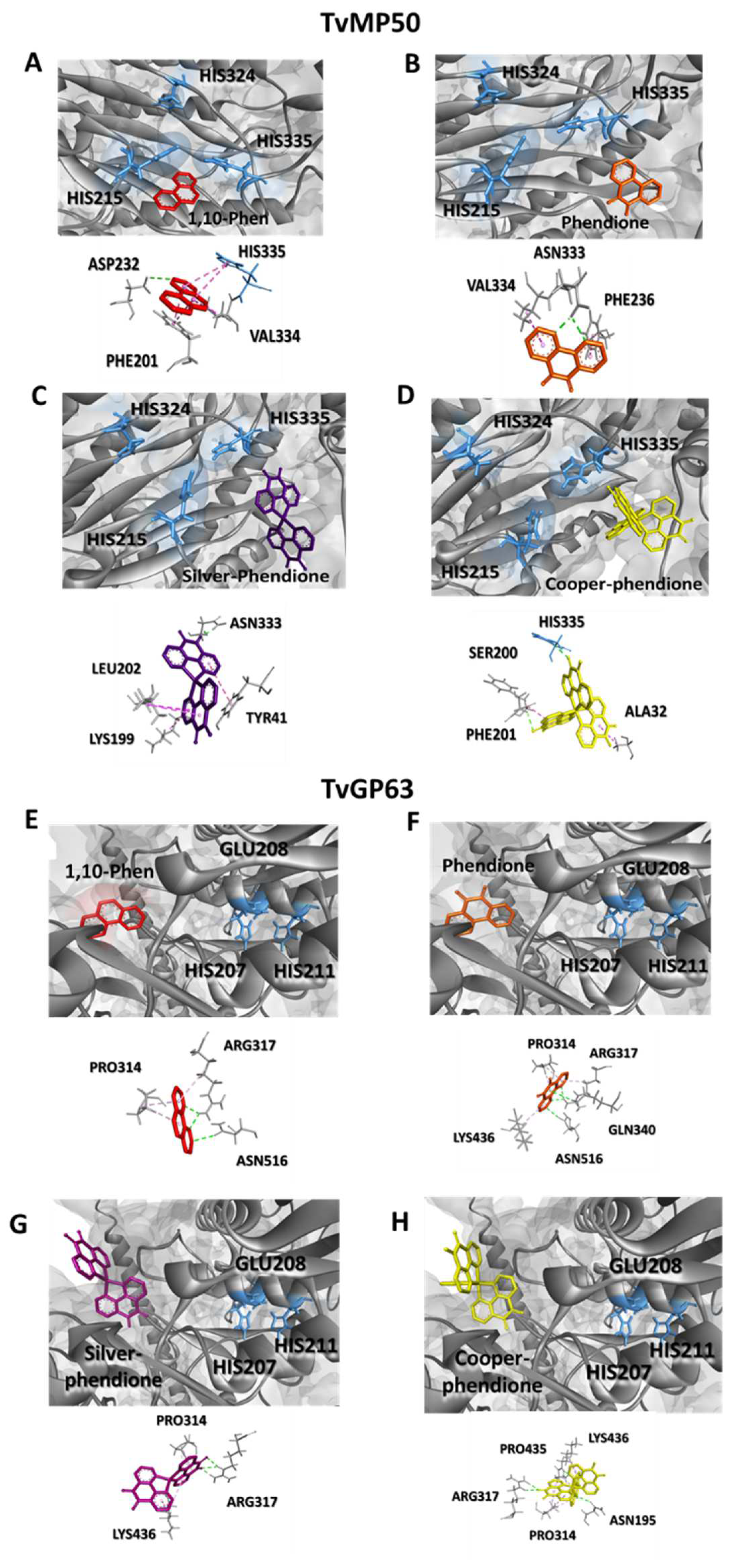

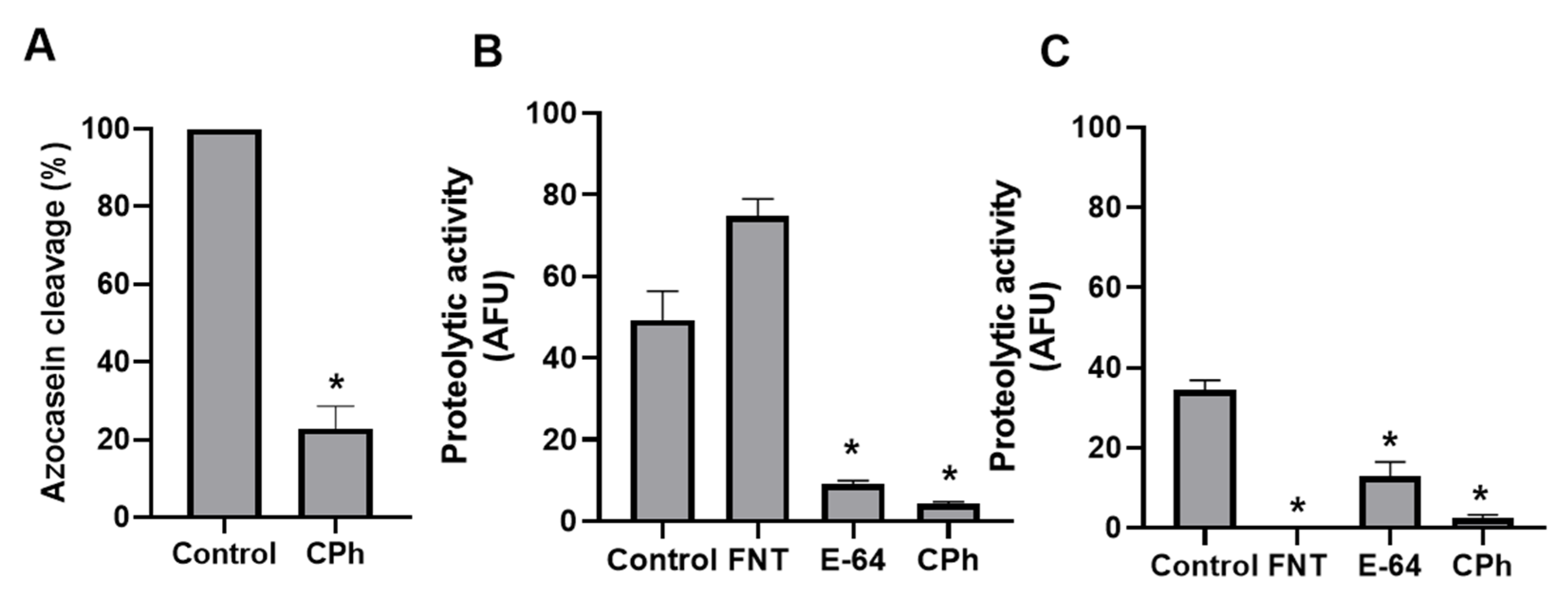
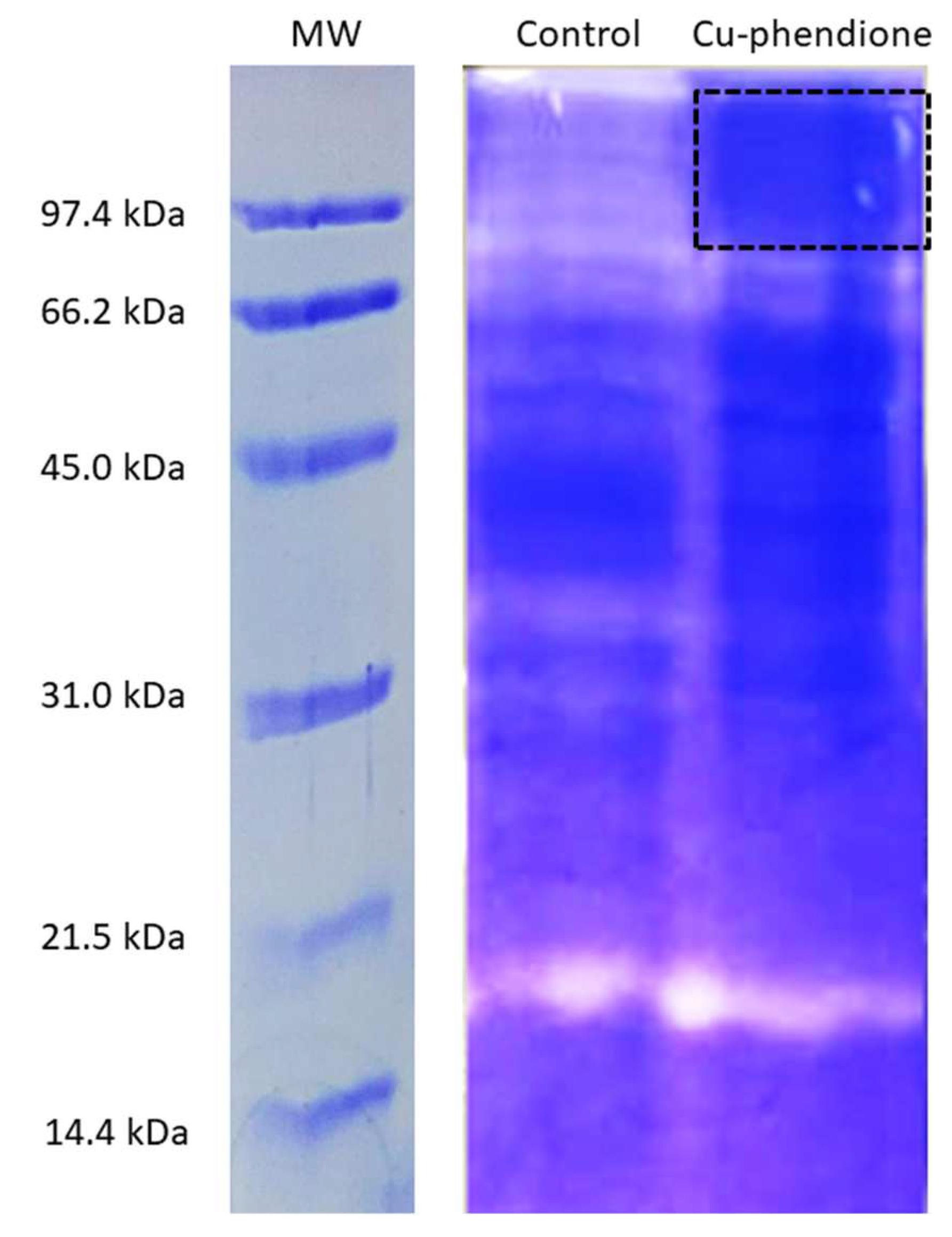
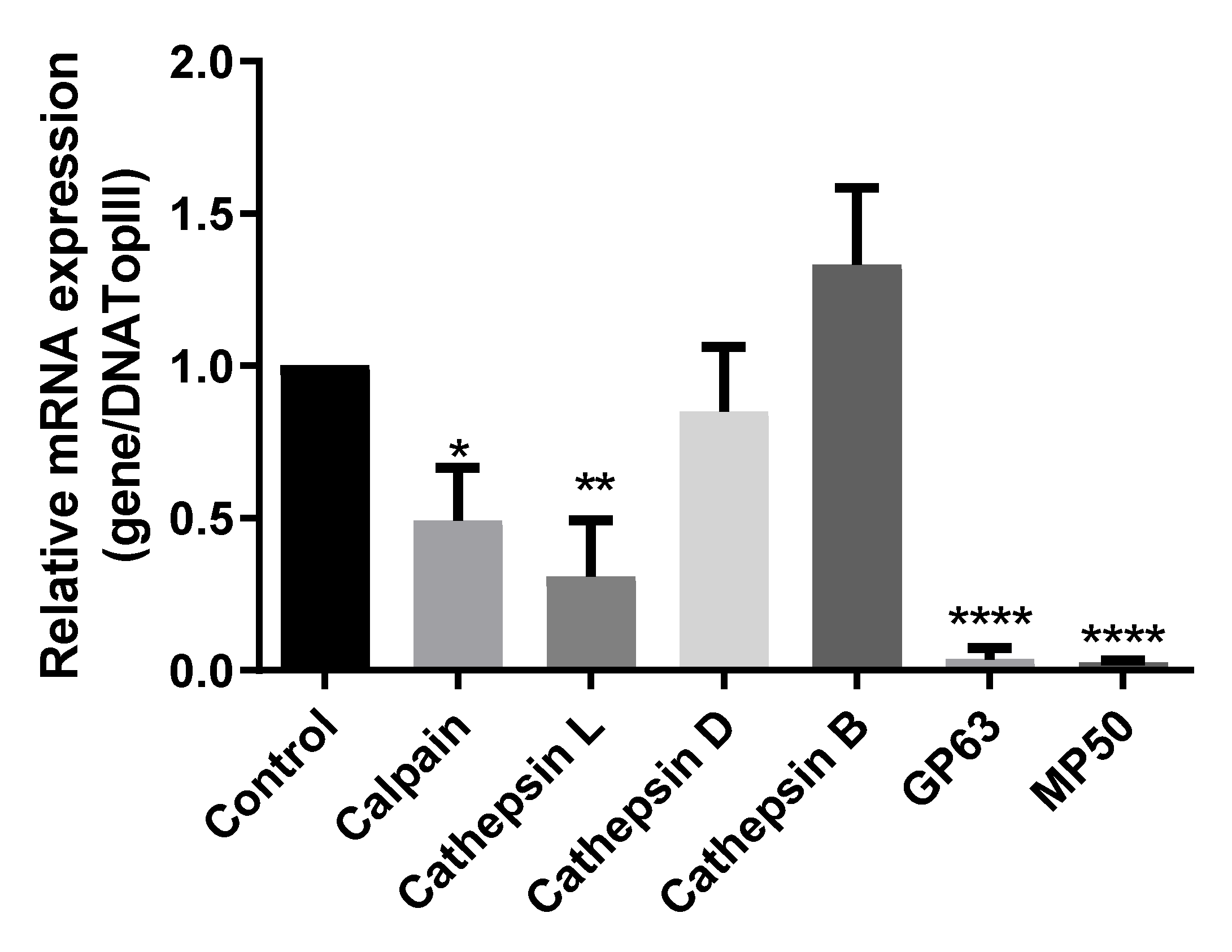
| Identification | Primers (5′-3′) | Primer Concentration | Annealing Temperature (°C) |
|---|---|---|---|
| Calpain (TVAG_161170) | F: CCA AAG GAT GCA CGA ATT TT R: GCG GAC ATT AGC TGG TTT GT | 0.2 | 60 |
| Cathepsin L (TVAG_057000) | F: CTG AAC TCG CTA AGG CTG CT R: GTT GCG GAC GAT CCA GTA GT | 0.1 | 68 |
| Cathepsin D (TVAG_336300) | F: TAC AAC CCA GAT GCT TTC TC R: GCA TAG ATG TGC CTG TAT CA | 0.2 | 64 |
| Cathepsin B (TVAG_488380) | F: CAA GAG TGC GGT TGT TGC TA R: TAA GCG CAT GCT GTT CAA GA | 0.2 | 60 |
| TvGP63 (GU356538.1) | F: ACG CTG TCC TTG CAA TTC TT R: TTG CGT TTT CTT TTG TGC AT | 0.1 | 60 |
| TvMP50 (TVAG_403460) | F: TCT CGA CTG CGG ATT CTT CT R: TCC GAC GTG ATG AGT CAA AC | 0.1 | 64 |
| Compounds | Binding Affinity (kcal·mol−1) | Interaction Type | Amino Acid | Distance (Å) |
|---|---|---|---|---|
| 1,10-Phenanthroline | −6.0 | Hydrogen bonding | ASP232 | 3.47 |
| Hydrophobic | PHE201 | 4.02 | ||
| 4.81 | ||||
| HIS335 | 4.98 | |||
| 5.46 | ||||
| VAL334 | 4.87 | |||
| 5.22 | ||||
| Phendione | −6.1 | Hydrogen bonding | ASN333 | 2.02 |
| 2.46 | ||||
| Hydrophobic | PHE236 | 4.62 | ||
| VAL334 | 5.18 | |||
| Ag-Phendione | −8.8 | Hydrogen bonding | ASN333 | 1.96 |
| 2.99 | ||||
| Hydrophobic | TYR47 | 5.22 | ||
| LEU202 | 5.24 | |||
| LYS199 | 5.37 | |||
| LEU202 | 4.68 | |||
| Cu-phendione | −9.7 | Hydrogen bonding | HIS335 | 2.46 |
| PHE201 | 2.49 | |||
| Hydrophobic | SER200/PHE201 | 4.42 | ||
| ALA32 | 5.29 |
| Compounds | Binding Affinity (kcal·mol−1) | Interaction Type | Amino Acid | Distance (Å) |
|---|---|---|---|---|
| 1,10-Phenanthroline | −6.0 | Hydrogen bonding | ARG317 | 2.50 |
| 2.37 | ||||
| ASN516 | 3.17 | |||
| Hydrophobic | PRO314 | 4.10 | ||
| 4.84 | ||||
| ARG317 | 4.99 | |||
| Phendione | −6.5 | Hydrogen bonding | ARG317 | 2.53 |
| 2.43 | ||||
| ASN516 | 3.13 | |||
| GLN340 | 3.31 | |||
| Hydrophobic | PRO314 | 5.03 | ||
| 4.15 | ||||
| ARG317 | 4.98 | |||
| LYS436 | 5.44 | |||
| Ag-Phendione | −8.2 | Hydrogen bonding | ARG317 | 2.58 |
| 2.62 | ||||
| 1.80 | ||||
| Hydrophobic | LYS436 | 5.00 | ||
| 5.49 | ||||
| PRO314 | 5.18 | |||
| 4.25 | ||||
| 5.18 | ||||
| Cu-phendione | −10.7 | Hydrogen bonding | ARG317 | 2.47 |
| 2.13 | ||||
| ASN195 | 3.23 | |||
| LYS436 | 3.04 | |||
| Hydrophobic | 4.40 | |||
| 4.98 | ||||
| PRO435 | 5.41 | |||
| PRO314 | 4.81 | |||
| 4.83 | ||||
| 4.05 | ||||
| 4.89 |
| Compounds | Binding Affinity (kcal·mol−1) | Interaction Type | Amino Acid | Distance (Å) |
|---|---|---|---|---|
| Cu-phendione | −8.7 | Hydrogen bonding | LYS312 | 2.88 |
| 2.99 | ||||
| 2.34 | ||||
| ASP171 | 3.36 | |||
| Electrostatic | 3.35 | |||
| Hydrophobic | TYR210 | 5.41 | ||
| VAL174 | 5.37 |
| PGLS a | UniProt | ||
|---|---|---|---|
| Protein Code | Gene | Identification | Molecular Weight |
| A2G9D4 | TVAG_387200 | GP63-like | 58.572 |
| A2DH40 | TVAG_193260 | ubiquitin hydrolase-like cysteine peptidase | 179.696 |
| A2DWM7 | TVAG_202060 | Ubiquitin (carboxy-terminal) hydrolase-cysteine peptidase | 254.796 |
| Treatment Condition | LDH Release (%) | |
|---|---|---|
| HMVII | VERO | |
| Triton X-100 | 100 | 100 |
| Tv ATCC 30236 | 3.8 ± 0.033 | 7.4 ± 0.217 |
| Tv ATCC 30236 + CPh | 0 ± 0.004 | 0 ± 0.030 * |
| TvLAC-M22 | 8.8 ± 0.03 | 28.6 ± 0.047 |
| TvLAC-M22 + CPh | 0 ± 0.01 * | 0 ± 0.061 * |
| TvLAC-M15 | 9.4 ± 0.010 | 29.6 ± 0.238 |
| TvLAC-M15 + CPh | 0 ± 0.009 * | 0 ± 0.113 * |
| TvLAC-H4 | 6.7 ± 0.012 | 29.3 ± 0.010 |
| TvLAC-H4 + CPh | 0 ± 0.03 * | 0 ± 0.026 * |
Disclaimer/Publisher’s Note: The statements, opinions and data contained in all publications are solely those of the individual author(s) and contributor(s) and not of MDPI and/or the editor(s). MDPI and/or the editor(s) disclaim responsibility for any injury to people or property resulting from any ideas, methods, instructions or products referred to in the content. |
© 2023 by the authors. Licensee MDPI, Basel, Switzerland. This article is an open access article distributed under the terms and conditions of the Creative Commons Attribution (CC BY) license (https://creativecommons.org/licenses/by/4.0/).
Share and Cite
Rigo, G.V.; Cardoso, F.G.; Pereira, M.M.; Devereux, M.; McCann, M.; Santos, A.L.S.; Tasca, T. Peptidases Are Potential Targets of Copper(II)-1,10-Phenanthroline-5,6-dione Complex, a Promising and Potent New Drug against Trichomonas vaginalis. Pathogens 2023, 12, 745. https://doi.org/10.3390/pathogens12050745
Rigo GV, Cardoso FG, Pereira MM, Devereux M, McCann M, Santos ALS, Tasca T. Peptidases Are Potential Targets of Copper(II)-1,10-Phenanthroline-5,6-dione Complex, a Promising and Potent New Drug against Trichomonas vaginalis. Pathogens. 2023; 12(5):745. https://doi.org/10.3390/pathogens12050745
Chicago/Turabian StyleRigo, Graziela Vargas, Fernanda Gomes Cardoso, Matheus Mendonça Pereira, Michael Devereux, Malachy McCann, André L. S. Santos, and Tiana Tasca. 2023. "Peptidases Are Potential Targets of Copper(II)-1,10-Phenanthroline-5,6-dione Complex, a Promising and Potent New Drug against Trichomonas vaginalis" Pathogens 12, no. 5: 745. https://doi.org/10.3390/pathogens12050745
APA StyleRigo, G. V., Cardoso, F. G., Pereira, M. M., Devereux, M., McCann, M., Santos, A. L. S., & Tasca, T. (2023). Peptidases Are Potential Targets of Copper(II)-1,10-Phenanthroline-5,6-dione Complex, a Promising and Potent New Drug against Trichomonas vaginalis. Pathogens, 12(5), 745. https://doi.org/10.3390/pathogens12050745









